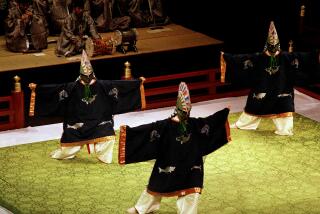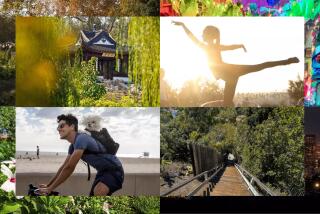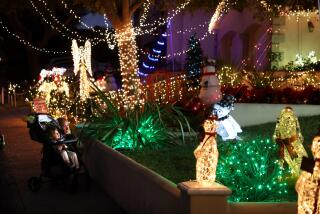Debate Continues Over the Rejection of Shinto Rite : Torrance: Is it art or religion? The city’s decision to prohibit a ritual at the dedication of the Cultural Arts Center stirs vigorous discussion.
At the opening day of the 1990 Los Angeles Festival, an array of Pacific Rim artists and spiritual leaders gathered for blessings on a cliff above the Pacific Ocean in San Pedro.
The rituals included a four-hour purification ceremony conducted by four Korean women shamans, or religious leaders.
“We were presenting an arts festival. We made very much a point in the festival about the interrelationship between the spiritual and art,” recalled Claire Peeps, the festival’s program director.
Now, Torrance officials have banned another kind of opening ritual--a Shinto ceremony rooted in Japanese culture--that was to have been part of a dedication ceremony for the new Cultural Arts Center.
The city’s decision is drawing criticism from some arts experts who say the city may have misconstrued the purpose of the event, but an ACLU attorney said the city must be cautious because of its involvement in the program.
The performing arts of many cultures are deeply rooted in religion, said Alma Robinson, executive director of California Lawyers for the Arts, a nonprofit statewide group.
“If you don’t participate in that religion, it’s not a religious experience for you. It’s more of a cultural tradition,” Robinson said.
Robinson pointed out that the Torrance City Council opens its weekly meetings with a prayer.
A key issue facing California, Robinson said, is “how inclusive we’re going to be. . . . To say you can do one thing at a City Council and can’t do another thing at an arts center is not inclusive.”
The prayer that opens City Council meetings is different, since the courts have protected invocations at the start of legislative sessions, city officials said.
The city, citing the separation of church and state, is forbidding a Shinto priest from performing a blessing ceremony at the $13-million Cultural Arts Center. The city also will not let an actor substitute for the priest.
The centuries-old ritual was to be the opening act at a showcase of traditional Japanese arts and music Jan. 10 and 11. The event’s main organizer, Mikko Haggott-Henson, says she has told the city that the ceremony is meant to be cultural, not religious.
That ceremony, known as kokera otoshi , is “very much a cultural tradition,” said Katsumi Kunitsugu, executive secretary of the Japanese American Cultural and Community Center in Los Angeles.
It was performed at the 1983 opening of Los Angeles’ Japan America Theater, which is run by a nonprofit group but was built in part with federal funds.
The Torrance decision is “a very narrow interpretation of the separation of church and state,” Kunitsugu said.
Judy Mitoma, a UCLA dance professor who helped organize the Los Angeles Festival opening, said: “The whole point is, it’s a theatrical occasion. It’s in a theater, not a church.
“What does it mean when someone’s doing gospel singing?” said Mitoma, who is also involved in the Torrance event. “Somebody’s feeling God inside of them, and I’m sitting there looking at them. . . . I can witness that. It informs me. It’s not that they’re trying to convert you.”
The Japanese arts showcase is sponsored in part by the Torrance Sister City Assn., a group that promotes ties with Kashiwa, Japan.
It will feature five artists from Japan, including Katada Kisaku, an internationally known percussionist. About 30 Los Angeles artists will also take part.
The kokera otoshi originally was to have five parts, Haggott-Henson said.
First, a Shinto priest would purify the theater by shaking a paper wand. Then a Kabuki performer would throw salt toward the four corners of the theater, and a theater representative would present Kisaku with a drumstick wrapped in ceremonial paper. The percussionist would then play a welcoming song, and a Kabuki-style dancer would perform a dance inviting good fortune.
Because of the city’s concerns, Haggott-Henson said, she is canceling the first three parts.
Some arts officials say they are especially surprised the city will not allow the ceremony even with an artist substituting for the priest.
“If an actor does it, that’s a performance, that’s a re-enactment,” said Dan Sheehy, assistant director of the folk arts program at the National Endowment for the Arts in Washington. “If you were to get married by a minister who is not a minister, are you married?”
But Herbert Plutschow, a UCLA Japanese studies professor, said that in Japan, “This would definitely be a religious ceremony.”
The new Torrance Cultural Arts Center, built with city funds, opened Oct. 25.
One issue troubling city officials is that the Shinto ceremony would take place in a new public building. Whether it is conducted by a Shinto priest or an actor, “It’s a religious dedication of a city facility,” Mayor Katy Geissert said.
Another problem is that the city is donating the theater and technical help for the Japanese arts showcase, City Atty. Kenneth L. Nelson said. When the city puts money or resources into a program, Nelson said, “it is inappropriate and unconstitutional for the program to include a religious ceremony.”
But Nelson said Friday that he will contact Haggott-Henson next week “to see if we can come up with a solution that solves the constitutional problems.”
Carol Sobel, a staff attorney for the ACLU of Southern California, said Friday that the Torrance ceremony differs from the Los Angeles Festival in that the city is donating the theater and technical services.
“It raises serious questions when the city is sponsoring it,” she said.
Sobel believes that deleting part of the opening ceremony is a “good compromise.”
Not everyone in city government agrees with the decision to bar the Shinto ceremony.
Robert Stewart, the Cultural Arts Center’s manager, said: “I think it would have added to the program, personally. . . . As a piece of art, I saw nothing wrong with it.”
And City Councilman William Applegate said he is encouraging the meeting between Nelson and Haggott-Henson aimed at resolving the dispute.
“I don’t see that there’s any harm in what they’re intending to do” in the ceremony, Applegate said.
But Councilman George Nakano said he agrees with Nelson’s decision.
“I believe that it’s a religious ritual,” Nakano said, adding that Nelson’s decision confirmed that belief. He does not believe the ritual could take place unless it was moved outside the city’s Cultural Center.
Told that some artists say the blessing could be seen as a cultural event, Nakano said, “My feeling is that a lot of people don’t know anything about Eastern religion, and they’re making comments.”
Kabuki expert Leonard Pronko, a Pomona College theater professor, said that Kabuki performances often start with a dance that has distant ties to Shinto ritual. He said he had never heard of a controversy such as that in Torrance.
“I wonder if . . . a Native American dance company wanted to perform a ceremony like this--would they not allow this, either?” Pronko asked.
More to Read
Sign up for Essential California
The most important California stories and recommendations in your inbox every morning.
You may occasionally receive promotional content from the Los Angeles Times.










